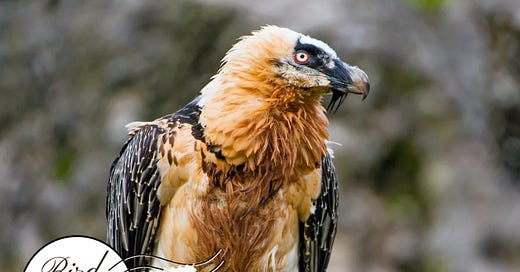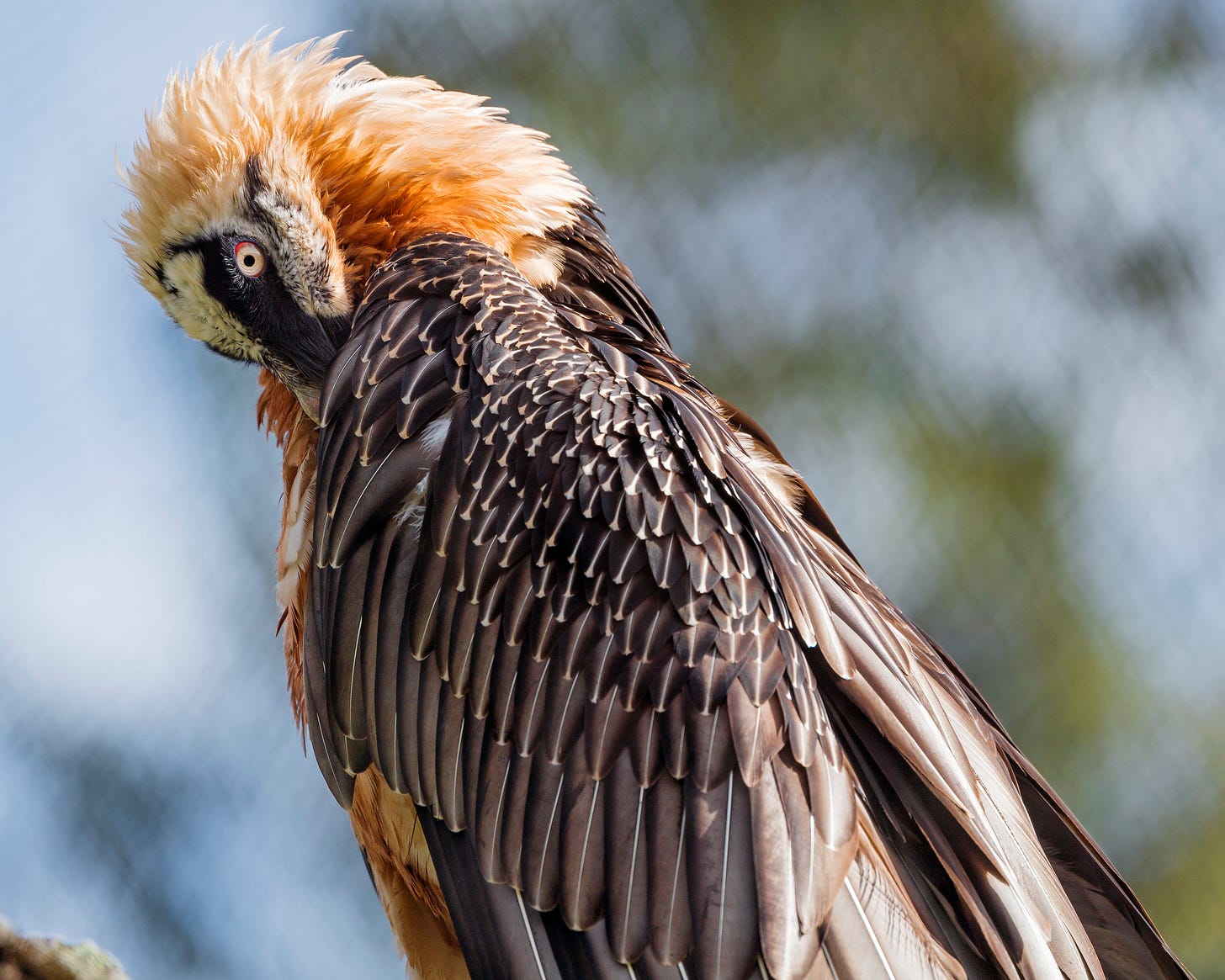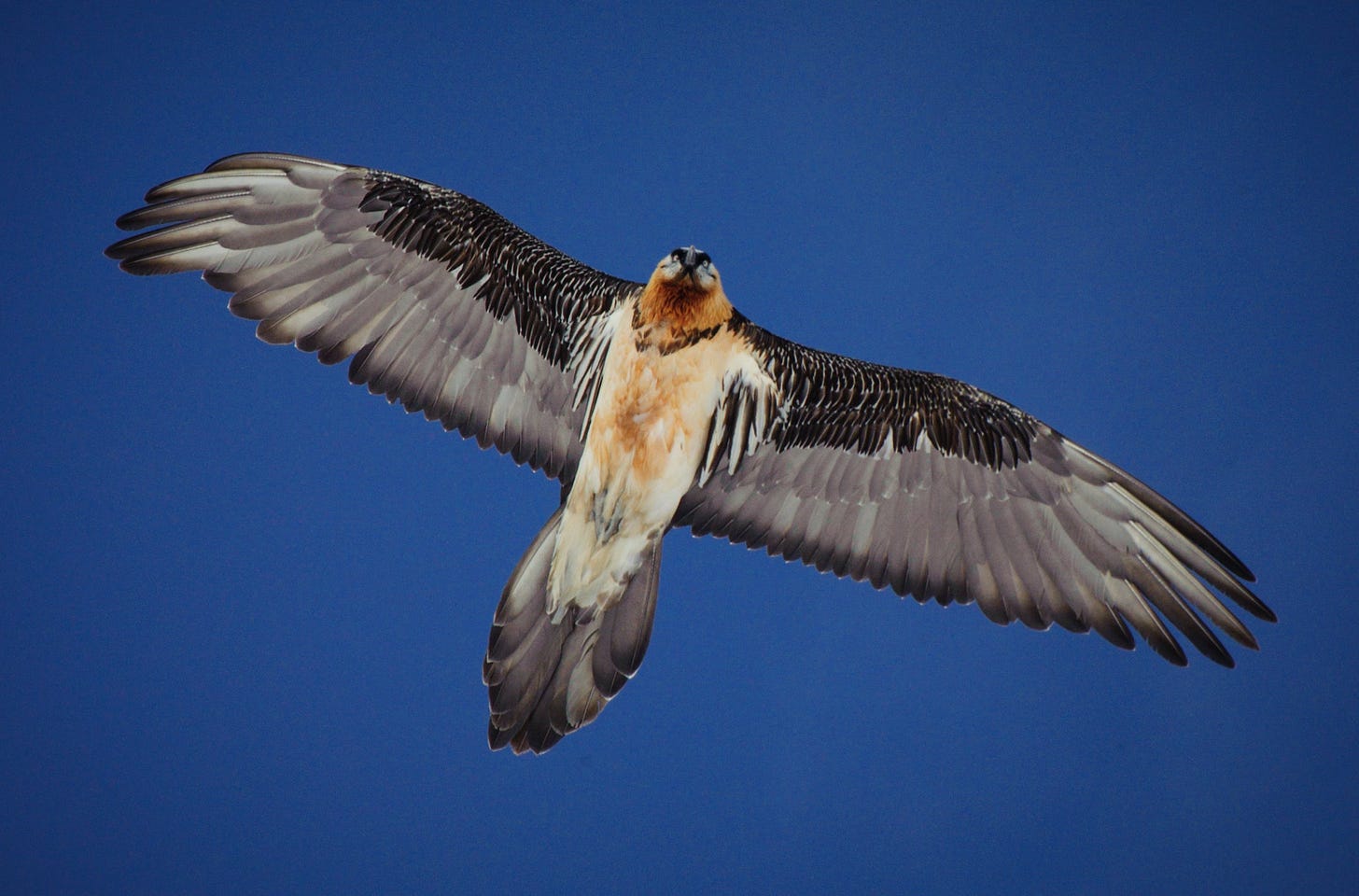
At the risk of over-generalizing, it seems fair to say that the birds we select here on Bird of the Week usually fall into two broad categories: the cuddly/beautiful/adorable kind and the gnarly/weirdo/freaky kind. For the past few entries, we’ve been heavy on the cuddly/beautiful/adorable birds. Doves! Orioles! Pigeons! Toucans! Even more toucans! It is thus high time that we brought you a gnarly/weirdo/freaky bird. And my oh my, do we have a doozy for you.
Meet….the lammergeier.
Holy bejeezus, what am I looking at! (“The lammergeier, Jack, you just said its name like one line ago.” OK, OK, I’m doing rhetoric here.) The black-and-orange, that jagged, almost celestial white pattern on the feathers, the eyes??? This…this is a bird. The intensity of that stare is just, wowza. You want to back away from it and it’s just a picture!
We were first alerted to the existence of the lammergeier by Discourse Blog reader Andrew McDonnell, who wrote us about this immortal avian way back in March. From Andrew’s email:
These birds are bonkers. They have other names, but I insist that the most intense one be used. [Ed. note: your wish is our command.] I’ve been fascinated by these ever since I saw them on PBS in the 80s…I defy you not to love them.
Andrew said some other things, but I have snipped them out so as to preserve the “element of surprise.” Here’s another picture.
Just incredible scenes taking place here. It really is quite gorgeous in its way, though it’s somewhat hard to see such a beautiful creature in the wild, as, to quote the Audubon Society, the lammergeier “is only found among the tallest peaks of the Eastern hemisphere: the Pyrenees, Mount Everest, the European Alps, the Ethiopian Highlands, the Atlas and Drakensberg Mountains, and the islands of Corsica and Crete.” So just go up Mount Everest and you might see one!
Let’s tackle one of the facts Andrew mentioned: the multiple names of the lammergeier. It’s often referred to by two other names: the bearded vulture and the ossifrage.
Here is where I part ways with Andrew, or at least see the name issue as slightly more complicated. We agree completely that “bearded vulture” is a pretty ho-hum name (it’s a vulture, and you can see it’s doing a little beard-like thing with its feathers. Real creative, English language). And we also agree that, of the three names, “lammergeier” does indeed sound the most intense. (It has a very 80s death-metal ring to it.)
HOWEVER. However. If you’re ranking things by the meanings of the words, “ossifrage” jumps out in front. That is because, while “lammergeier” is a German word that translates to “lamb vulture” (something that stems from a seemingly mythical belief that they targeted lambs), “ossifrage” is an old Latin term that, when translated, accurately, and thrillingly, sums up just what makes this particular bird so very immortal:
“BONE-BREAKER.”
ooooooooooooooooooooooooooooooooooooooooooooooooooooooooooooo
That’s right, we’re talking BONES today, and not the TV kind that Aleks used to blog about, but the real, in-the-body kind. That’s because the lammergeier is, say it with me, a bird that FEASTS ALMOST ENTIRELY ON BONES.
YES! Just typing it makes me happy. Freaky-ass birds forever!!! (Also let’s have a plug for the Spanish name for this bird, “quebrantahuesos.”) OK, let’s get into it. From the World Wide Fund For Nature (emphasis mine):
The bearded vulture is the only animal that feeds almost exclusively on bone (70-90%). In Crete, it is known as the "bone-eater". The bird throws the larger bones from a height on to rocky slopes in order to break them, and immediately descends after them in a characteristic spiral.
If the bone does not break the first time, the method is repeated many times until the bone finally breaks. The bird then eats the bone pieces starting with the bone marrow. The smaller bones are swallowed whole, as the bird's gastric fluids are so strong that they can digest bone easily. This dietary habit seems odd, but once bones have been digested, they are a nutritious and easily storable type of food; in addition, the bird faces minimal competition for this type of food.
Just to emphasize how wild this is, I’ll quote from Wired:
For pretty much every other creature on Earth, bone is indigestible. Hyenas will chew through the odd bone here and there with their powerful jaws, but that’s by no means their main source of food. Owls, which eat things like mice whole, have to regurgitate the bones. Bearded vultures find this unacceptable: They dig bone so much they’ve been known to eat owl throwup.
I have nothing to add to that.
Here’s some videos showing this awe-inspiring activity.
It really does take all kinds to make a world. Why let perfectly good bones go to waste??? Andrew has more details:
Generations of lammergeiers will use the same drop zones, and adults spend years training the kids in proper technique.
Wonderful. Some other facts about lammergeiers: they’re very big (up to three feet tall!) they’re monogamous; and they like to dye their feathers using iron-rich dirt and mud that leaves them with their distinctive reddish-orange hue, for reasons that do not appear entirely clear. They are the only birds known to do this.
All of this has made humans understandably fascinated with lammergeiers throughout history. They show up in the Bible among a list of birds not to be eaten because they are an “abomination” (a bit harsh); they are seen as symbols of good fortune in Iran; and they are considered sacred birds in Tibet.
Lammergeiers are also speculated to play a role in one of the most famous bird-related legends in Ancient Greek history: many identify it as the bird that supposedly killed the playwright Aeschylus by dropping a tortoise on his head. (In the lammergeier’s defense, the bird is said to have mistaken Aeschylus’ bald head for a rock. Understandable!)
Unfortunately, this fascination has also had a severe downside. From Audubon again (emphasis mine):
[T]he bird’s many other outlandish traits [make] it easy to vilify. And that’s exactly what humans have done, with decades of slander, hunting, and poisoning that have contributed to a massive collapse in its populations. By 1986 the species was completely extinct in the Alps, and it remained so until conservationists from 14 organizations banded together and founded a captive-breeding program at one of Austria’s national parks. Over the next 16 years they released 184 birds throughout Europe, and have since set up the International Bearded Vulture Monitoring project to study wild individuals. Putting a number on the current global population is difficult, given the species’ attachment to higher altitudes, but it’s estimated to be somewhere between 1,300 and 6,700.
You dumb human idiots!!!!!! Leave the lammergeier alone! It just wants to eat bones and chill. It’s good that the population has crept back up, but still: just let this amazing specimen do its thing and everything will be cool! Ugh!
Let’s end this on a happier note: this picture of what is unquestionably one of the world’s greatest birds. Keep soaring forever, bone-breaker!
A reminder: you can check out our complete Bird of the Week list here, and get in touch with your bird suggestions at hello@discourseblog.com.





















THESE BIRDS ARE THE GREATEST